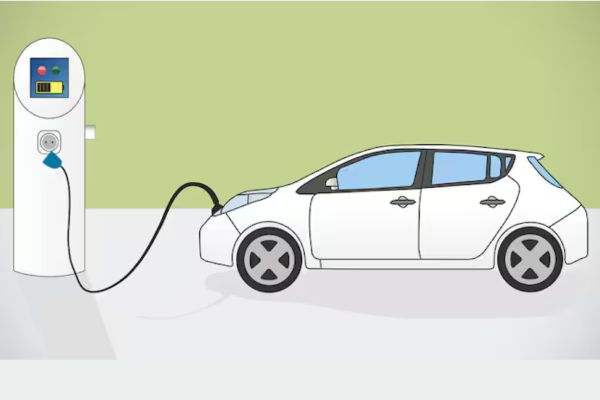The global electric vehicle charging station market size is expected to Reach around USD 480.57 billion by 2034 from USD 44.52 billion in 2024 with a CAGR of 26.85%.
Electric Vehicle Charging Station Market Key Insights
- In 2024, the Asia Pacific region led the EV charging station market, holding the largest share at 49.78%.
- By charging level, the Level 2 segment dominated with a 66.24% market share.
- By charging station type, DC charging stations accounted for approximately 75% of total revenue.
- By mode of charging, the plug-in charging segment held the highest share at 86%.
- By end user, the residential segment captured the largest market share at 65%.
- By application, public chargers accounted for over 85% of the market share.
Role of Artificial Intelligence in Electric Vehicle (EV) Charging Station Market
1. Smart Charging & Energy Management
- Load Balancing: AI optimizes power distribution across multiple chargers to prevent grid overload.
- Demand Response: Predicts peak demand and adjusts charging rates to reduce energy costs.
- Renewable Energy Integration: Balances energy from solar and wind sources for sustainable charging.
2. Predictive Maintenance & Fault Detection
- Real-time Monitoring: AI detects potential charger malfunctions and schedules preventive maintenance.
- Self-Healing Networks: Identifies and resolves issues automatically, minimizing downtime.
3. Dynamic Pricing & Cost Optimization
- Time-of-Use Pricing: AI adjusts charging costs based on electricity demand and grid conditions.
- Personalized Pricing Models: Offers discounts or premium rates based on user behaviour and subscription plans.
4. Smart Navigation & Charging Station Recommendation
- EV Routing Assistance: AI suggests the best charging stations based on location, battery level, and traffic.
- Real-time Availability Updates: Helps drivers find available chargers, reducing wait times.
5. User Experience & Personalization
- Voice & Chatbot Assistance: AI-powered chatbots assist users with charging queries and troubleshooting.
- Adaptive Charging Profiles: Learns user preferences and automatically applies preferred charging settings.
6. Grid Integration & Vehicle-to-Grid (V2G) Technology
- Grid Stabilization: AI facilitates bidirectional energy flow, allowing EVs to supply power back to the grid.
- Smart Load Forecasting: Predicts energy demand and optimizes grid performance.
7. Security & Fraud Prevention
- AI-based Authentication: Uses facial recognition or RFID to prevent unauthorized charging.
- Anomaly Detection: Identifies fraudulent activities such as meter tampering or unauthorized access.
Electric Vehicle Charging Station Overview
An Electric Vehicle (EV) Charging Station is a facility that supplies electric energy to recharge electric vehicles. These stations vary in charging speed, connector types, and usage scenarios, playing a crucial role in EV adoption worldwide.
1. Types of EV Charging Stations
By Charging Level:
- Level 1 Charging (Slow Charging)
- Uses a standard 120V AC outlet.
- Charging speed: ~4-5 miles of range per hour.
- Ideal for overnight home charging.
- Level 2 Charging (Fast AC Charging)
- Requires a 240V AC outlet or dedicated charging station.
- Charging speed: ~10-60 miles of range per hour.
- Common in homes, workplaces, and public locations.
- DC Fast Charging (DCFC) (Rapid Charging)
- Uses direct current (DC) instead of alternating current (AC).
- Charging speed: ~60-250 miles of range in 15-30 minutes.
- Found at highways, commercial areas, and high-traffic locations.
- Ultra-Fast Charging (Extreme DC Fast Charging)
- Power output: 350 kW or more.
- Can charge an EV battery to 80% in less than 15 minutes.
- Used for high-performance EVs and long-distance travel.
2. Types of Charging Stations by Accessibility
- Public Charging Stations – Available in malls, parking lots, and highways for general use.
- Private Charging Stations – Installed at homes or workplaces for personal or employee use.
- Fleet Charging Stations – Designed for commercial EV fleets, such as taxis, buses, and delivery vans.
- Wireless Charging Stations – Uses inductive charging technology for contactless energy transfer.
3. Key Components of an EV Charging Station
- Power Supply Unit – Connects to the grid or renewable sources.
- Charging Connector & Cables – Compatible with various EV models.
- Software & Network System – Enables remote monitoring, payments, and smart charging.
- User Interface (UI) – Screen or mobile app for interaction and charging control.
4. Modes of Charging
- Plug-in Charging – Requires a physical connection between the EV and charging unit.
- Wireless Charging – Uses electromagnetic fields for contactless power transfer.
- Vehicle-to-Grid (V2G) Charging – Allows EVs to send electricity back to the grid.
5. Key Market Trends & Developments
- AI & IoT Integration – Smart charging stations optimize power use and predict maintenance needs.
- Renewable Energy Integration – Solar and wind-powered charging stations are growing.
- Ultra-Fast Charging Infrastructure – Expansion of 350kW+ chargers for long-distance travel.
- Government Incentives – Many countries provide subsidies and tax benefits for EV charging infrastructure.
6. Challenges in EV Charging Infrastructure
- Grid Load Management – High demand for charging can stress the electricity grid.
- Standardization Issues – Different EV brands use different connectors and charging protocols.
- Initial Installation Costs – Setting up a charging network requires high investment.
- Limited Charging Stations – Rural and remote areas still lack widespread coverage.
7. Future of EV Charging Stations
- Ultra-Fast & Wireless Charging Expansion.
- AI-Powered Smart Charging Networks.
- Integration with Smart Cities & Autonomous Vehicles.
- Advancements in Battery Technology for Faster Charging.
Regional Outlook of the Electric Vehicle (EV) Charging Station Market
Asia Pacific
- Market Size: Asia Pacific’s EV charging station market was valued at USD 22.16 billion in 2024 and is projected to reach approximately USD 239.47 billion by 2034.
- CAGR: The region is expected to grow at a CAGR of 26.89% from 2025 to 2034.
- Market Share: Asia Pacific held the largest market share in 2024, accounting for 49.78% of the global market.
- Growth Drivers:
- Significant investments by governments in China, South Korea, Japan, and other Asian countries to expand charging infrastructure.
- China’s substantial investment of USD 1.43 billion in 2020 to maintain its lead in EV adoption.
- Government initiatives in Singapore, India, Korea, and Japan to promote EV adoption through investments in charging infrastructure.
- China having approximately 566,000 public charging stations operational as of July (according to August 2020 data).
- The Japanese government’s plan to transition all new car sales to electric or hybrid vehicles by 2050, aiming to reduce carbon emissions significantly.
Europe and North America
- Growth: These regions are experiencing moderate growth in the EV charging station market.
- Growth Drivers:
- Government initiatives aimed at reducing carbon emissions and increasing EV adoption rates.
- Concentration of charging stations in specific European countries (Germany, France, UK, and the Netherlands, accounting for 76% of Europe’s total).
- Volkswagen Group’s plan to install 36,000 EV charging points across Europe by 2025.
- A commitment of USD 1.3 billion by New York, New Jersey, and California (U.S.) to deploy EV charging infrastructure.
- U.S. Market:
- The U.S. is the third-largest market for electric vehicles.
- The number of registered EVs in the U.S. increased from under 300,000 in 2016 to over 1.1 million in 2020.
- California has been proactive in establishing charging station networks.
- As of 2021, there were over 42,000 publicly accessible charging stations in the U.S.
- UK Initiatives:
- The Electric Vehicle Home charge Scheme (EVHS) offers subsidies for home charging point installation.
- The Workplace Charging Scheme (WCS) helps with upfront costs for purchasing and installing wall chargers for businesses.
- European Initiatives:
- bp pulse is opening charging stations for medium- and heavy-duty electric trucks in Europe, with initial stations along the Rhine-Alpine route in Germany.
- France offers a tax credit covering 75% of the cost of installing EV charging stations, up to 300 euros, as part of the ADVENIR project.
Electric Vehicle Charging Station Market Companies
- ABB Ltd.
- ChargePoint, Inc.
- EVgo Services LLC.
- Allego
- Scheinder Electric
- Blink Charging Co.
- Wi Tricity Corporation
- Toshiba Corporation
- AeroViroment, Inc.
- Mojo Mobility, Inc.
- General Electric
- Robert Bosch GmbH
- Chargemaster plc.
- Evatran Group
- HellaKGaAHueck& Co.
- Siemens AG
- Leviton Manufacturing Co., Inc.
- Efacec
- Alfen N.V.
- Denso Corporation
- Elix Wireless
- Tesla Inc.
- ClipperCreek
- Engie
- Infineon Technologies AG
- Qualcomm Technologies, Inc.
Source: https://www.precedenceresearch.com/electric-vehicle-charging-station-market

















